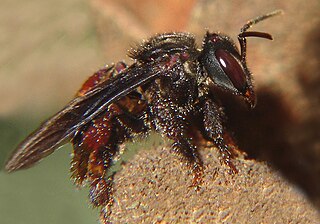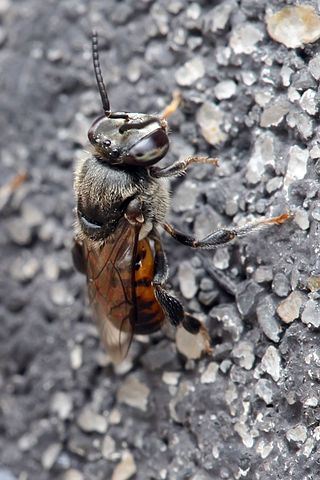Trigonisca atomaria
Trigonisca atomaria | ||||||||||||||||||||||
|---|---|---|---|---|---|---|---|---|---|---|---|---|---|---|---|---|---|---|---|---|---|---|
| Научная классификация | ||||||||||||||||||||||
| ||||||||||||||||||||||
| Латинское название | ||||||||||||||||||||||
| Trigonisca atomaria (Cockerell, 1917) | ||||||||||||||||||||||
| Синонимы | ||||||||||||||||||||||
|
Trigonisca atomaria (лат.) — вид безжальных пчёл из трибы Meliponini семейства Apidae. Не используют жало при защите. Хотя жало у них сохранилось, но в сильно редуцированном виде. Вид был впервые описан в 1917 году американским энтомологом Теодором Коккереллем (Theodore Dru Alison Cockerell; 1866—1948)[1].
Распространение
Неотропика: Коста-Рика (Alajuela, Guanacaste, Puntarenas), Панама (Chiriquí, Colón)[2][3][4][5].
Описание
Отмечено опыление растений Cecropia insignis (Moraceae), Socratea durissima, Elaeis oleifera (Palmae), Pouteria stipitata (Sapotaceae)[6], Sechium edule (Cucurbitaceae)[7] и хищничество термитов[8][9].
Примечания
- ↑ Cockerell, T. D. A (1917). New social bees. Psyche 24: 120—128 [127].
- ↑ Catalogue of Bees (Hymenoptera, Apoidea) in the Neotropical Region Архивная копия от 13 декабря 2013 на Wayback Machine (англ.)
- ↑ Michener, C.D. (2007) The bees of the world, second edition. Johns Hopkins University Press, Baltimore and London, 953 pp.
- ↑ Ramalho, M., Kleinert-Giovannini, A. & Imperatriz-Fonseca, V. L. (1990). Important bee plants for stingless bees (Melipona and Trigonini) and Africanized honeybees (Apis mellifera) in neotropical habitats: a review. Apidologie 21: 469—488 [473] (as Trigona atomaria, geographic record, habitat, pollen, citation)
- ↑ Roubik, D. W. (1983). Nest and colony characteristics of stingless bees from Panamá (Hymenoptera: Apidae). J. Kansas Entomol. Soc. 53 (6): 327—355 [330, 336, 340, 346—347, 352] (as Trigona (Trigonisca) atomaria, nesting site: tree cavity, geographic record, nest entrance, nest characteristics, nest population, nest density)
- ↑ Roubik, D. W., Enrique Moreno, J., Vergara, C. & Wittmann, D. (1986). Sporadic food competition with the African honey bee: projected impact on neotropical social bees. J. Trop. Ecol. 2: 97-111 [99, 101, 102, 104, 109] (as Trigona (Trigonisca) atomaria, geographic record, behavior, foraging activity, pollen, nectar, pollen records: Cecropia insignis (Moraceae), Socratea durissima, Elaeis oleifera (Palmae), Pouteria stipitata (Sapotaceae), competition)
- ↑ Wille, A., Orozco, E. & Raabe, C. (1983). Polinización del chayote Sechium edule (Jacq.) Swartz en Costa Rica. Revista de Biologia Tropical 31 (1): 145—154 [147] (as Trigona (Trigonisca) atomaria, geographic record, pollination: Sechium edule (Cucurbitaceae))
- ↑ Lorenzon, M. C. A., A. G. Bandeira, H. M. Aquino & N. Maracajá-Filho (1999). Relationship between Partamona (Hym., Apidae) and Constrictotermes (Isop., Termitidae) in the semiarid region of Paraíba state, Brazil. Rev. Nordestina Biol. 13 (1/2): 61-68 [66]
- ↑ Roubik, D. W. (1989). Ecology and natural history of tropical bees. New York: Cambridge University Press 1-514 +x pp. [242] (predator: termites)
Литература
- Albuquerque, P. M. C. & Camargo, J. M. F. (2007). Espécies novas de Trigonisca Moure (Hymenoptera, Apidae, Apinae). Rev. Bras. Entomol. 51 (2): 160—175 [160].
Ссылки
- Список таксонов на BioLib (англ.)
- eol.org







